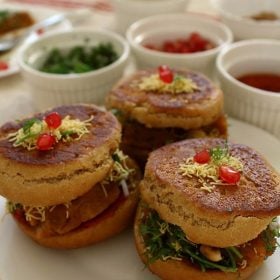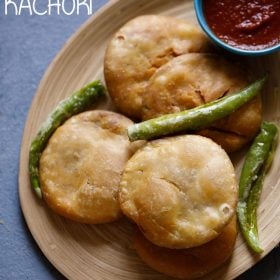Fafda Recipe
The Gujarati snack Fafda might sound funny when spoken, but it surely doesn’t taste funny. In fact, it tastes fab. And why shouldn’t it also? It is a crispy, crunchy fried snack. Thus, is highly addictive and scrumptious just like any other fried Indian snack. The Fafda Recipe is a simple one and the main ingredient of this preparation is gram flour (besan). My version is also laced with the flavors of carom seeds (ajwain) and black pepper (kali miri). So, I would actually call it better than what’s available in the markets.
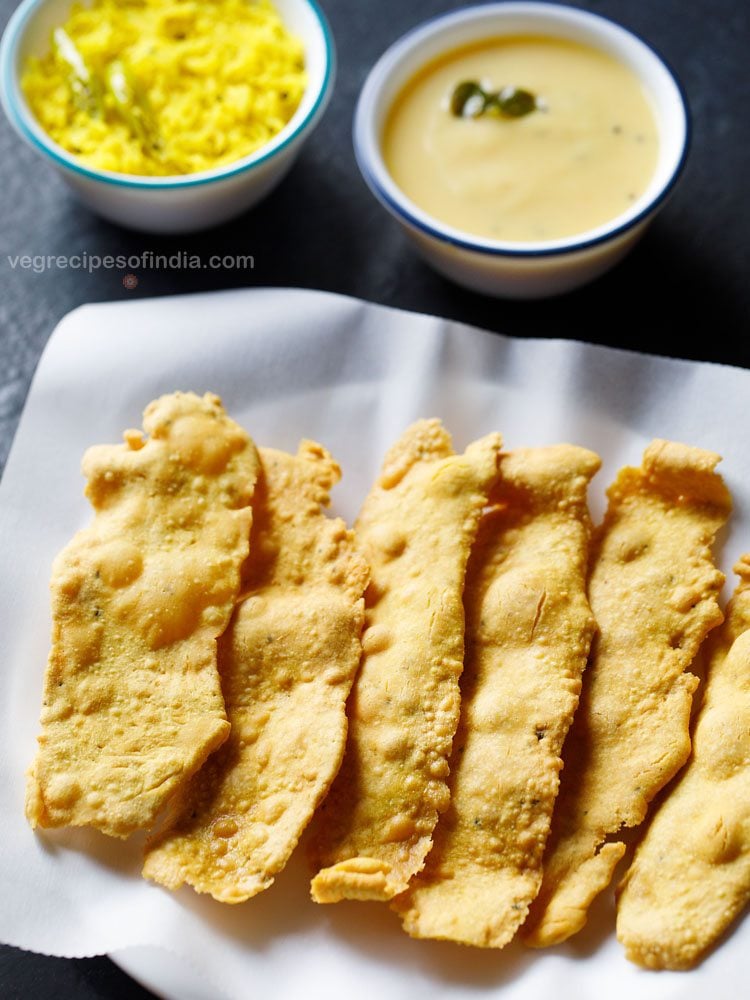
About Fafda
If there’s one sought-after food duo in Gujarati cuisine, it is the Fafda and Jalebi. I mean jalebi, otherwise also is a much-loved sweet snack pan India. But when it comes to a yummy sweet and salty combination, particularly in Gujarati food, this is what you should feed yourself.
Both these also make for an amazing breakfast choice as well as popular treats during festivals like Navratri, Dussehra and Diwali. Basically, Fafda is a fried rectangular snack, primarily made with gram flour or chickpea flour (besan). Since this is the main ingredient in the Fafda Recipe, the snack is also yellow in color.
Alongwith this, Fafda is flavored with ingredients like ajwain and black pepper. Even I have added these in my recipe. All this along with some baking soda, oil and salt in kneaded into a soft and smooth dough which is portioned and flattened/cut into elongated shapes of long rectangles.
Finally, these pieces are fried in hot oil till they get crisp. Today, Fafda is not just a super popular vegan snack in Gujarat, but other parts of the country as well as overseas.

Fafda served with Papaya Sambharo, besan chutney and fried green chilies is a smashing combination. Even I have memories of enjoying this pairing. At home, this has been one of our favorite breakfasts as well.
When I used to stay in Mumbai, I would buy Fafda along with the chutneys and some jalebis from a Gujarati snack shop close to our home. This was more or less customary during the weekends. During that time, I was working in the corporate sector and never used to get time to make such elaborate recipes at home.
Since the time I took to blogging and following my passion whole-heartedly, I have been frequently making this Fafda Recipe along with trying and testing many others at home itself. And I must say that nothing can beat the quality of homecooked or homemade food.
For the Fafda Recipe, you actually don’t need any many ingredients. Generally, papad khar is used in its making. Since this particular ingredient is not easily available, I have worked on a recipe that uses baking soda in it.
Like I mentioned earlier, Dussehra and Diwali festivals are the time when this snack with its accompaniments is sold like hot cakes in Gujarat. Making these at home is also not difficult. I find it quite easy and with this recipe you can make crispy, crunchy munchy Fafda without any hassle.
You know the best way to serve this snack, that is with the fried green chilies, besan chutney and the raw papaya sambharo. But you can also pair it with Gujarati besan kadhi. Have it warm or at room temperature, its just going to be fab.
Step-by-Step Guide
How to make Fafda
Making dough
1. In a bowl or parat (large plate with rims at the sides), take 1 cup gram flour (besan).

2. Add ¼ teaspoon carom seeds (ajwain), 10 to 12 coarsely crushed black peppercorns, ¼ teaspoon turmeric powder, 1 pinch asafoetida (hing) and ⅛ teaspoon or 2 to 3 pinches baking soda.

3. Mix very well with a spoon.

4. Now, add ¾ teaspoon salt or as per taste.
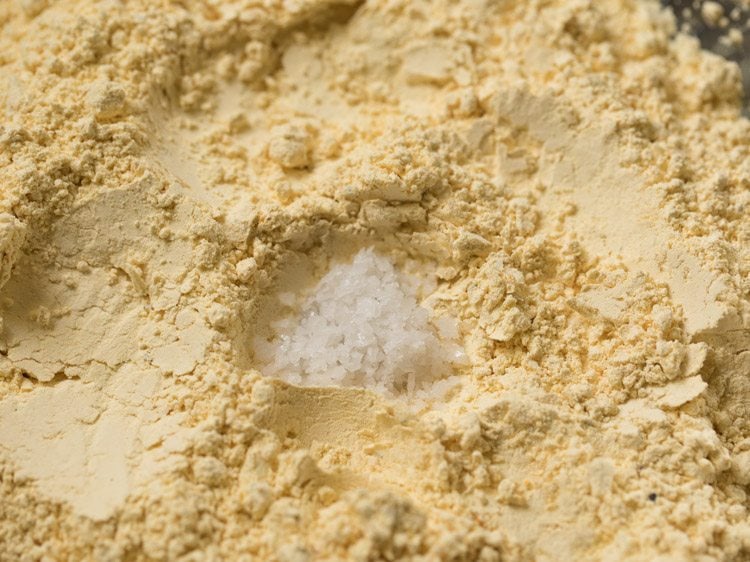
5. Add 2 to 3 tablespoons water in parts.
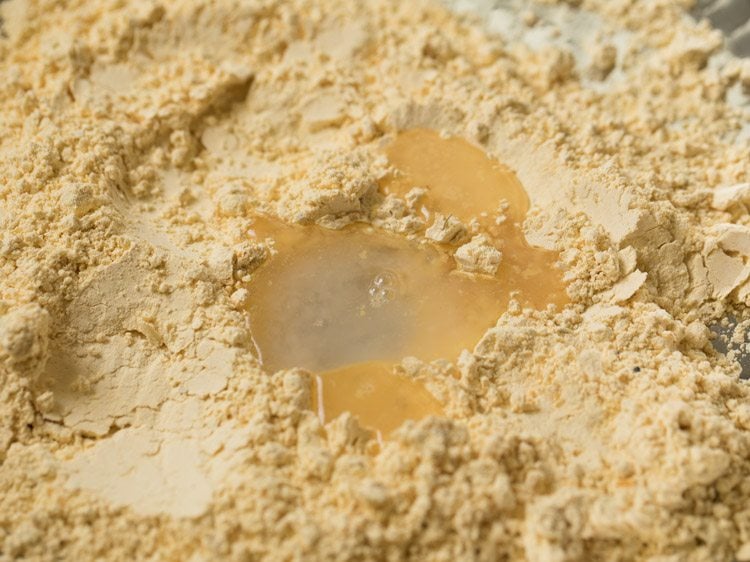
6. Begin to mix the water with the besan.
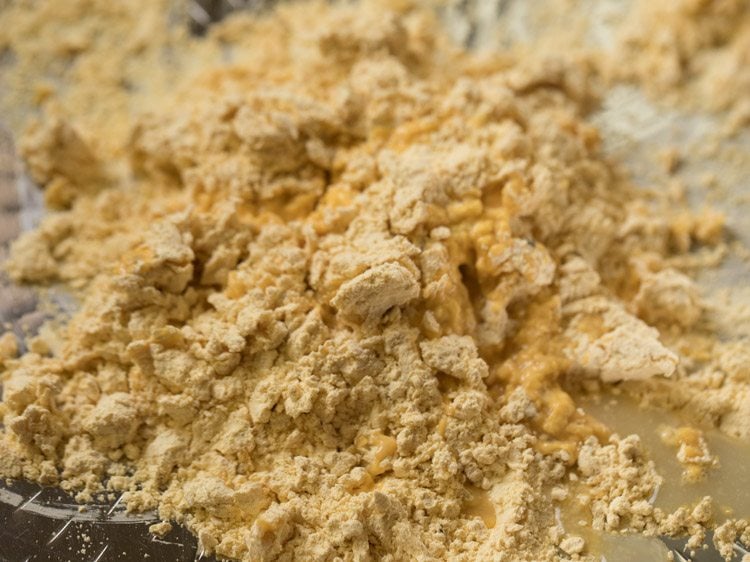
7. Then, knead to a stiff dough.

8. Now, add 2 tablespoons oil.

9. Mix again and continue to knead. Also, add water if required. Initially, I added 3 tablespoons water and after adding oil, added 1 tablespoon water. So, in total, I added 4 tablespoons water. Depending on the quality of besan, you can add a total of 3 to 4 tablespoons water.
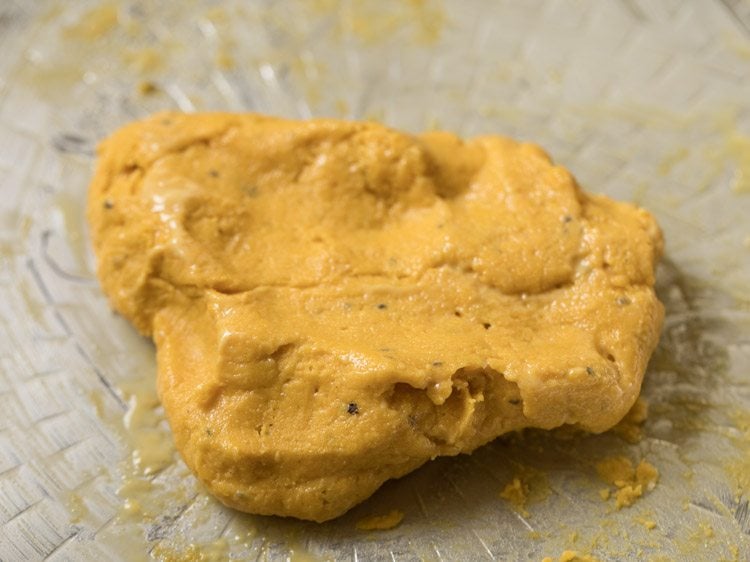
10. Continue to knead till all the water is absorbed.
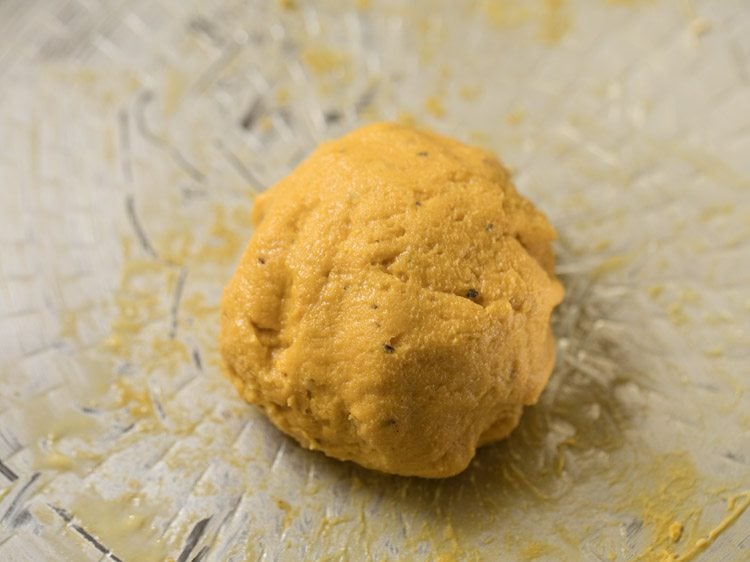
11. When the water is absorbed, the stickiness will go away and you will get a soft dough. So, knead till you get a soft, smooth dough. Cover and keep aside for 30 minutes.

Rolling Fafda
12. After 30 minutes, make small balls from the dough. Cover them with a lid or a kitchen towel so that they do not become dry.

13. On a wooden board, spread oil very lightly. Keep one dough ball on the lightly greased board. Do not grease the board with much oil as then the fafda cannot be pressed easily. Spread some oil on your hands if you want, before starting the next step.
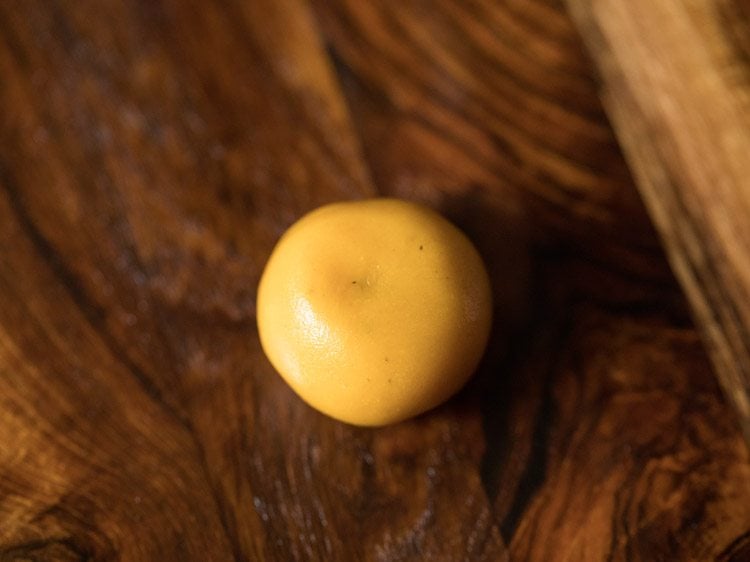
14. Now, with the heels of your palm and with a light pressure and force, press and flatten the dough ball and at the same time move the palms forward. Keep equal pressure throughout, but do not put a lot of pressure. If you apply too much pressure, then Fafda will stick to the board and will break while lifting. This is the only tricky part in the whole recipe. You need to apply light pressure as well as move further while pressing and flattening the Fafda dough.
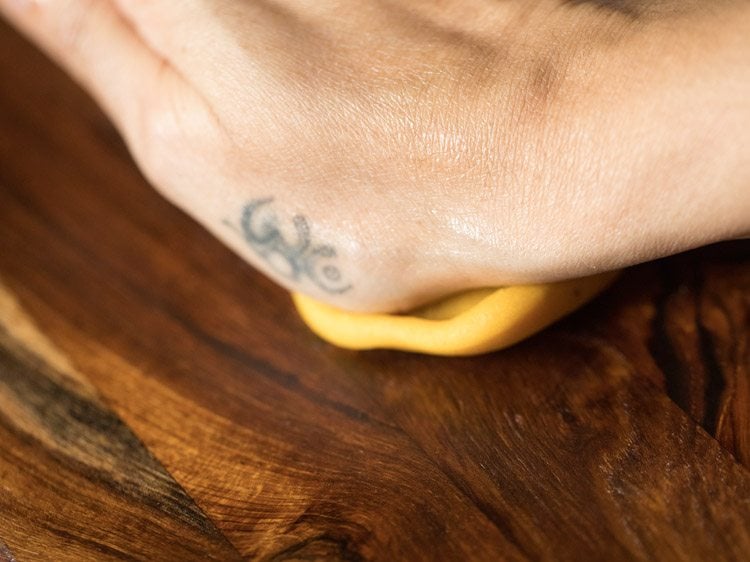
15. You will get a long elongated shaped Fafda. Gently pick it up from the board. Also, do not make it too thin, as then it cannot be lifted easily. You can also lift it with a knife or spatula. An alternate method is to roll a large piece of dough with a rolling pin (belan) on a greased rolling board (chakla). Then, with a knife, cut strips and remove them.

16. Keep it on a separate plate or board which has been greased lightly with oil. Make more Fafdas with the remaining dough balls. Cover with kitchen napkin, so that they do not become dry.

Frying Fafda
17. Heat oil in a kadai. When the oil becomes medium hot, check with a tiny piece of the dough. It should gradually come up on top of the oil.
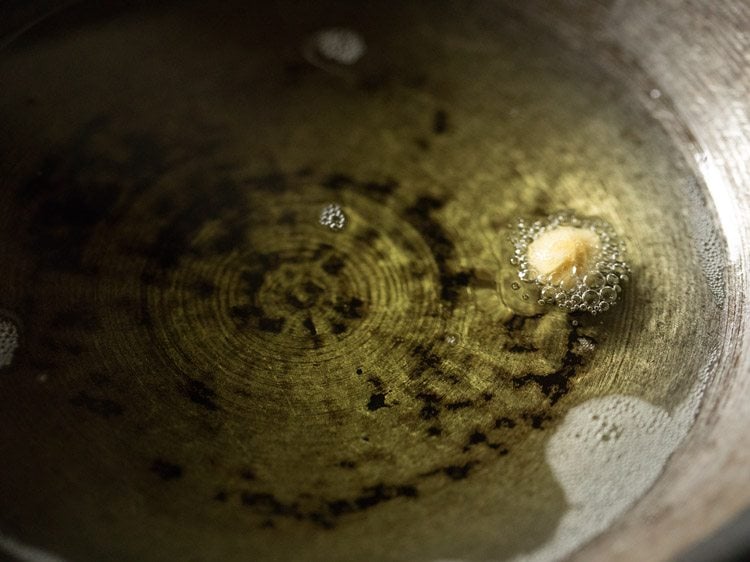
18. Now, reduce the heat to low-medium and add the Fafda pieces gently in the oil.
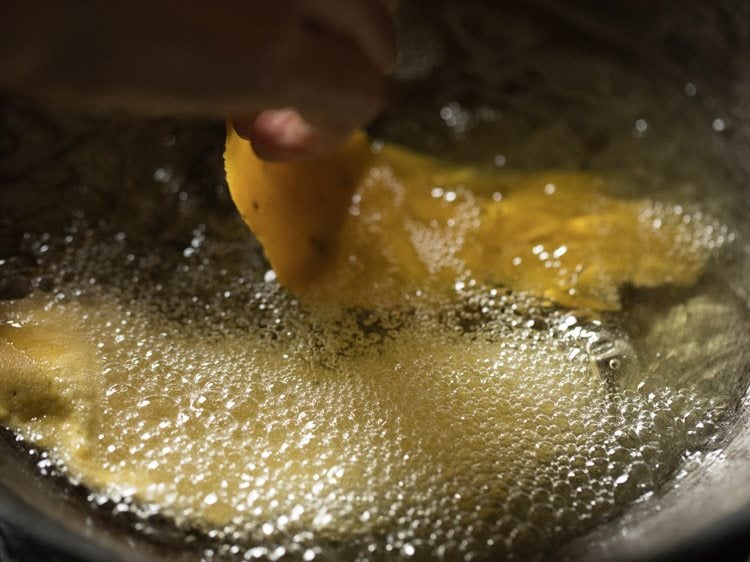
19. Do not overcrowd the kadai. Depending on the size of the kadai, you can add 3 to 4 pieces at a time.

20. Begin to fry on low-medium heat.

21. When one side is crisp and golden, with a slotted spoon gently turn over each piece and continue to fry.

22. Turn over again and fry till crisp. Do not fry till too much browned. Fafda gets fried quickly, so the frying needs attention.

23. Remove with a slotted spoon, draining excess oil.
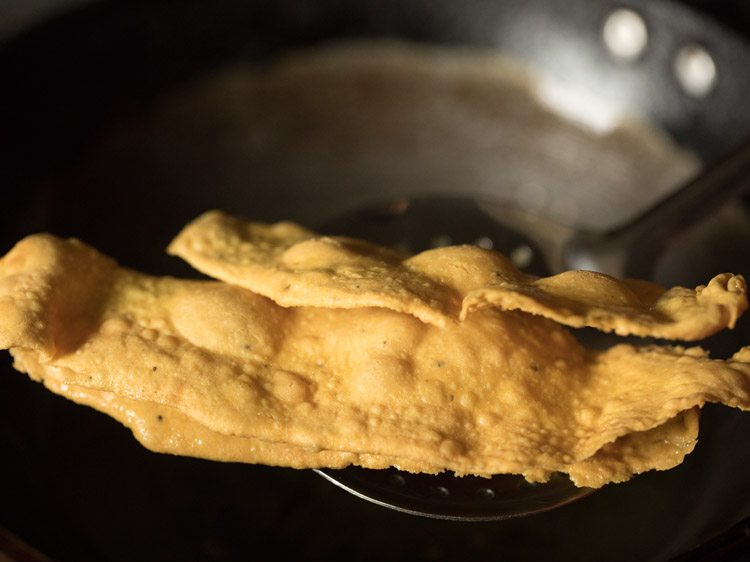
24. Place them on kitchen paper towels for extra oil to be absorbed. In the same way, fry the remaining batches.

25. Serve Fafda warm or at room temperature with papaya sambharo, fafda chutney or Gujarati kadhi.
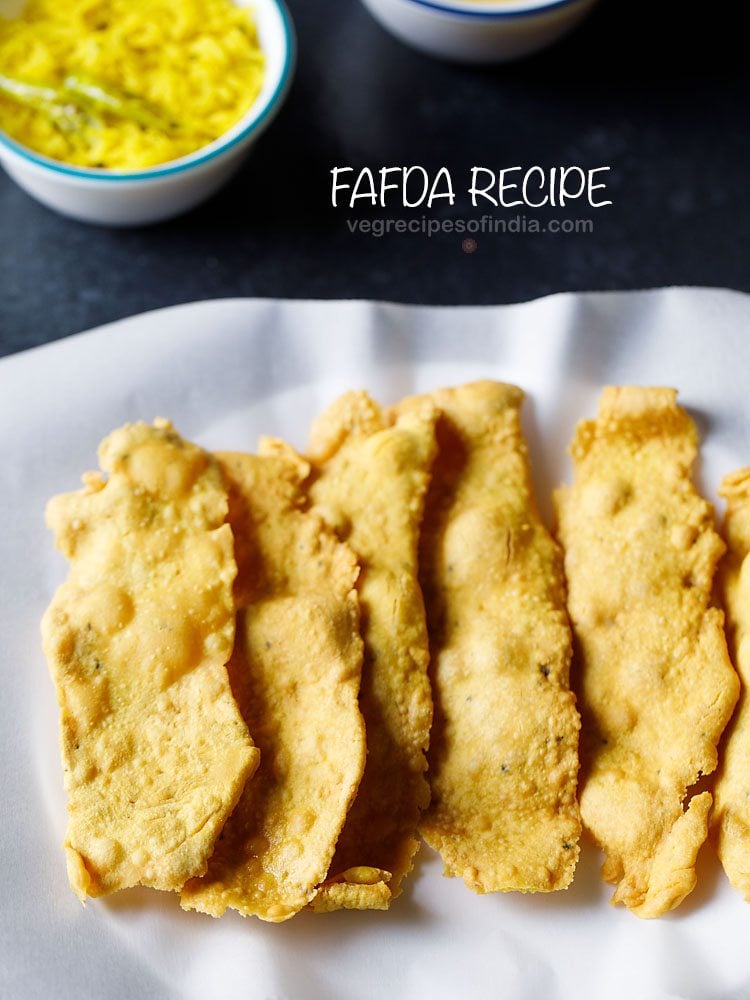
Expert Tips
- Depending on the quality of besan, you will have to add water to prepare the dough. Usually, it is somewhere between 3 to 4 tablespoons.
- If you are flattening the Fafda with your hands, then make sure to keep equal pressure throughout and not apply too much pressure. If you do that, then the Fafda will stick to the board and will break while lifting.
- Ensure not to make extremely thin Fafdas as then you will not be able to lift them easily.
- Another way of shaping this snack is to roll a large piece of dough with a rolling pin on a greased rolling board. Then, with a knife, cut into thick strips.
More Street Food Recipes To Try!
Street Food Recipes
Snacks Recipes
Street Food Recipes
Street Food Recipes
Please be sure to rate the recipe in the recipe card or leave a comment below if you have made it. For more vegetarian inspirations, Sign Up for my emails or follow me on Instagram, Youtube, Facebook, Pinterest or Twitter.
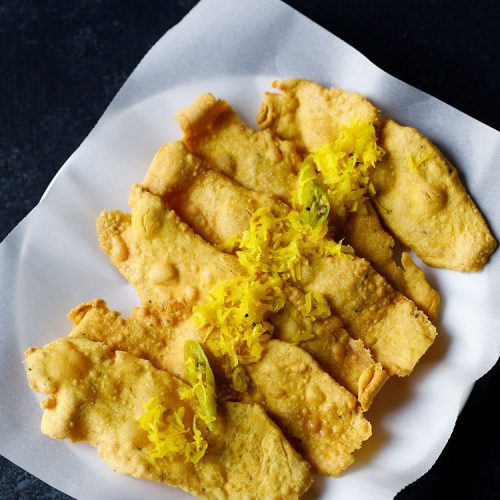
Fafda Recipe
Fafda is a fried crispy crunchy tasty snack made with besan (gram flour), laced with carom seeds and black pepper. A popular Gujarati vegan snack.
Prep Time 10 minutes
Cook Time 20 minutes
Total Time 30 minutes
making dough
In a bowl or parat (large plate with rims at the sides) take 1 cup besan (gram flour).
Add carom seeds (ajwain), crushed black pepper, turmeric powder and asafoetida (hing). Also add ⅛ teaspoon baking soda or 2 to 3 pinches of baking soda.
Mix very well with a spoon.
Now add ¾ teaspoon salt or add as per taste.
Add 2 to 3 tablespoons water in parts.
Begin to mix the water with the besan. then knead to a tight dough.
Now add 2 tablespoons oil. mix again and continue to knead.
Also add water if required. Initially I added 3 tablespoons water and after adding oil, added 1 tablespoon water. So in total I used 4 tablespoons water. Depending on the quality of besan, you can add a total of 3 to 4 tablespoons of water.
Continue to knead till all the water is absorbed.
When the water is absorbed, the stickiness will go away and you will get soft dough. So Knead till you get a soft smooth dough. cover and keep aside the dough for 30 minutes.
rolling fafda
After 30 minutes, make small balls from the dough. Cover them with a lid or a kitchen towel so that they do not become dry.
On a wooden board spread oil very lightly.
Now with the heels of your palms, with a light pressure and force, press and flatten the dough ball and at the same time move the palms forward.
If you apply too much pressure then fafda will stick to board and will break while lifting. This is the only tricky part in the whole recipe.
You will get a long elongated shaped fafda. Gently pick it up from the board.
An alternate method is to roll a large piece of dough with a rolling pin (belan) on a greased rolling board (chakla). Then with a knife cut strips and remove them.
Keep it on a separate plate which has been greased lightly with oil. Make fafda this way with the remaining dough balls. Cover with a kitchen napkin so that they do not become dry.
frying fafda
Heat oil in a kadai. When the oil becomes medium hot, check a small tiny piece of the dough. It should gradually come up on top of the oil.
Now reduce the flame to low-medium. Add the fafda pieces gently in the oil.
Do not overcrowd the kadai. Depending on the size of the kadai, you can add 3 to 4 pieces at a time.
Begin to fry at a low-medium flame.
When one side is crisp and golden, then with a slotted spoon gently turn over each fafda and continue to fry.
Turn over again and fry till crisp. Do not fry till too much browned. Fafda gets fried quickly, so the frying needs attention.
Remove with a slotted spoon draining excess oil.
Place them on kitchen paper towels for extra oil to be absorbed.
Serve them warm or at room temperature with papaya sambharo or fafda chutney or gujarati kadhi. or you can also enjoy the combo of fafda jalebi.
Nutrition Facts
Fafda Recipe
Amount Per Serving
Calories 88 Calories from Fat 54
% Daily Value*
Fat 6g9%
Sodium 161mg7%
Potassium 75mg2%
Carbohydrates 5g2%
Fiber 1g4%
Protein 1g2%
Vitamin A 10IU0%
Calcium 7mg1%
Iron 0.5mg3%
* Percent Daily Values are based on a 2000 calorie diet.
This Fafda Recipe from the archives was first published in May 2017. It has been updated and republished in March 2024.

